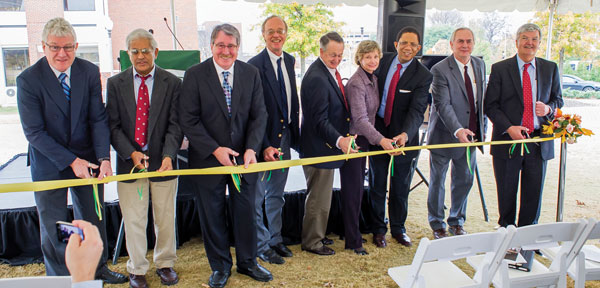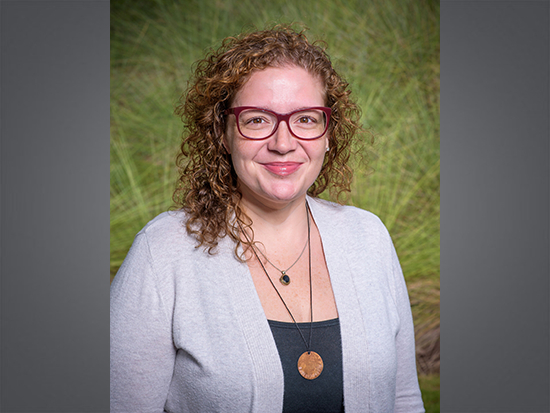UAB’s Nuclear Magnetic Resonance Facility
By Dale ShortSeeing brighter and sharper images of inside the human body has long been a goal of researchers and physicians. X-rays were a major breakthrough, but more recently the science of Nuclear Magnetic Resonance (NMR) was so revolutionary that it won two Nobel prizes for two different teams of scientists.
UAB’s new NMR facility is the largest and most advanced in the state. Its centerpiece is a Bruker BioSpin Avance III HD 850 MHz NMR spectrometer, equipped with a cryoprobe, a coil that’s cooled with a stream of very cold Helium gas to increase the probe’s sensitivity and reduce the level of thermal noise generated by the device’s components.
 “This puts UAB in the category of leading institutions that have this level of technology,” says N. Rama Krishna, Ph.D., professor of Biochemistry and Molecular Genetics and director of the NMR facility. “This facility is a unique platform that merges both basic science and translational research — from structural biology of proteins to drug discovery, and NMR-metabolic profiling of biofluids to assess toxicity and physiological changes induced by drugs.”
“This puts UAB in the category of leading institutions that have this level of technology,” says N. Rama Krishna, Ph.D., professor of Biochemistry and Molecular Genetics and director of the NMR facility. “This facility is a unique platform that merges both basic science and translational research — from structural biology of proteins to drug discovery, and NMR-metabolic profiling of biofluids to assess toxicity and physiological changes induced by drugs.”Using technology that sprang from World War II radar designs, NMR devices use powerful magnets that target the hydrogen nuclei of proteins. The nuclei respond by producing signals that can be encoded by the machine and converted into data points of an image.
Big Lab On Campus
“The new facility has been intricately designed with power, HVAC, security, and vibration dampening capabilities,” Krishna says, “that make it one of the best designed NMR facilities in the U.S. The consolidation of the 19th Street and 14th Street NMR Cores into a central facility will allow for more efficient maintenance, scheduling and upkeep of the NMR systems, more economical usage of the cryogens involved, and the availability in one location of a critical mass of NMR scientists with expertise in mutually complementary areas to support the research projects of Cancer Center faculty members.”And the facility redesign brings an aesthetic bonus as well, says Dr. David Graves, chair of the Department of Chemistry. “There’s a big ‘wow’ factor with this facility and its view of the beautiful Campus Green,” he says. “We included as many windows as possible, to show off the facility and illustrate our commitment to research excellence. We can do a lot more collaboratively than we can do separately, and this partnership among the Department of Chemistry, Department of Biochemistry and Molecular Genetics, the School of Medicine, and the College of Arts and Sciences clearly reflects this synergy.”
“Drs. Rama Krishna and David Graves have built a world-class NMR facility at UAB,” says Tim Townes, Ph.D., chair of the Department of Biochemistry and Molecular Genetics. “The 850 MHz NMR spectrometer with cryoprobe is a state-of-the-art spectrometer that can define the structure and dynamic movements of proteins at the atomic level.
“The facility provides state-of-the-art sensitivity and resolution for biomedical research and drug discovery . . .” — N. Rama Krishna
While the facility will be helping researchers solve puzzles of proteins for years to come, bringing the pieces together in their interdisciplinary framework was a major puzzle of logistics in itself.Early in 2009, when Krishna’s High End Instrumentation grant for a 800 MHz NMR system with a cryoprobe was funded by the National Institutes of Health-National Center for Research Resources, the size of the magnet outshone the size of the loading dock’s corridor at the 19th Street facility known as CH19. Installing the machine there would require major construction and renovation, with a price tag to match. Krishna and chemistry chair David Graves, Ph.D. conferred about the option of relocating the 19th street facility instruments and combining them with the Department of Chemistry’s NMR systems operating at 700 MHz, 400 MHz, and 300 MHz.
This Plan B would have required upgrading the magnet to a “compact shielded” version, as well as renovating parts of the Chemistry building. The plan was proposed to UAB leadership. What happened next was, as Krishna puts it, “serendipity.” Twice.
First, the manufacturer of the Bruker-Biospin machine announced a new compact shielded version of their Ascend 850, which is small enough to fit in a single story lab such as the Chemistry Building. Not long afterward, the National Cancer Institute announced a new competition for American Recovery and Reinvestment Act (ARRA) supplements to Cancer Center Support (CCSG) Grants, of the type that help support the Comprehensive Cancer Center, which would be aimed at consolidating Cancer Center Cores.
Krishna and Graves wrote and submitted an application for consolidating the NMR instruments to a Chemistry Building location. The grant was funded, work began on renovating the space, and the new facility was set to house all four NMR instruments.
The largest device will mainly support structural biology studies on high molecular weight proteins and their complexes, Krishna says, and the 700 model will continue to support structural biology in addition to cancer drug discovery projects. The 600 system is dedicated to studies of metabolomics—chemical processes involving metabolites, which have been described as “the chemical fingerprints that specific cellular processes leave behind” — in addition to work on peptides, smaller proteins, complex carbohydrates, and nucleic acids. The 500 system will assist in heteronuclear observation, and the 400 and 300 systems will be used chiefly for synthetic chemistry research.
 The new NMR facility grand opening was held in November. It has been intricately designed with power, HVAC, security, and vibration dampening capabilities.Collaboration
The new NMR facility grand opening was held in November. It has been intricately designed with power, HVAC, security, and vibration dampening capabilities.Collaboration
“One aspect of the new installation that will multiply its impact is its collaborative nature,” says Edward Partridge, M.D., director of UAB’s Comprehensive Cancer Center. “This new facility is going to take biomedical research to the next level — not only with its state-of-the-art instrumentation, but most importantly, with the collaborative expertise of our researchers, who will better our understanding of disease and disease progression. UAB as a whole has long been recognized for its efforts in drug discovery and development. When it comes to cancer, this facility is going to play a pivotal role in creating therapeutic agents in the laboratory, helping us nurture it through the ‘research pipeline’ of tests, animal studies, and clinical trials before it’s ultimately brought to our patients.”The installation’s name is as substantial as its equipment list: The Central Alabama High-Field Nuclear Magnetic Resonance Facility, which was derived from the title of Krishna’s successful High End Instrumentation grant funded by the NCRR. At 1,600 square feet and $3.5 million, the facility was created as a multidisciplinary partnership of the NIH-NCRR, UAB Health Services Foundation, National Cancer Institute, the offices of the vice president for Research and Economic Development and the deans of the School of Medicine and the College of Arts and Sciences.
According to director Krishna, the facility “provides state-of-the-art sensitivity and resolution for biomedical research and drug discovery” for a wide-ranging list of diseases including cancer, hypertension, diabetes, atherosclerosis, cardiovascular disease, HIV-1, Parkinson’s disease, and others. It combines the new machines with existing instrumentation from the university’s chemistry, biochemistry, and molecular genetics departments.
“These precise measurements are essential to gain insights into the proteins that cause disorders as diverse as cancer, diabetes, Parkinson’s, and cardiovascular disease. Equally important, the state-of-the-art NMR facility further strengthens the Structural Biology Program at UAB and helps us attract outstanding students into our Graduate Biomedical Sciences Program.”


